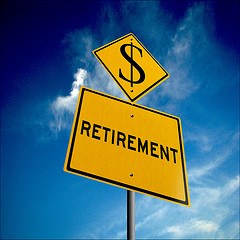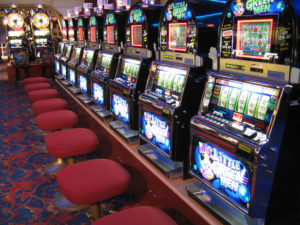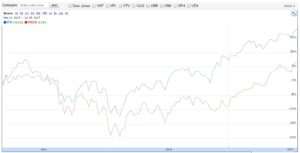I’m trying to build my audience, so if you like this post, please share it on social media using the buttons right above.
This one’s a biggie. Actually I was going to do a post entitled “How much do I need to retire?” However, in order to answer that huge question you need to answer three sub-questions:
- How much will I spend in retirement?
- How much will I save during my working years?
- When will I retire?
Once you answer those three questions, I think you can have a pretty good idea of what your number needs to be and ultimately when you can pull the ripcord on retiring. So with that said, I guess I’m kicking off a three-part series.
Determining the amount you will spend in retirement is a really hard thing to do. That’s not really comforting given that your monthly spending has a huge impact, as you would expect, on the amount you need to retire with. So for example, if you plan on spending $5000 per month in retirement (all numbers are going to be in today’s dollars unless otherwise noted), you would need about $1.3 million when you retire*. However, if you increased that monthly spending to $6000 then your nestegg would need to be $1.5 million. Push the monthly number up to $10,000 and your nestegg needs to be $2.5 million. Obviously, that monthly number is incredibly important in your planning. So clearly when you start figuring out your financial plan, you need to have a decent idea of what you’re going to spend in retirement.
Unfortunately, this is no easy task. There are a couple approaches you can take, all of which leave something to be desired.
- Percentage of income: The most common approach you hear is to take your current income, take a percentage of it (often people suggest 80%) and plan on spending that in retirement. I DESPISE this approach for a few reasons. Take two identical couples, the Foxes and the Grizzlys, both of whom make the same amount of money, let’s say $150,000. According to that formula we should take $150,000 and multiply it by 80% to get $120,000, and that’s what we should plan on spending in retirement. That means both families need a nestegg of about $2.5 million
First, I think when you use this approach, you get a number that is way too high. Very few families are spending 80% of their salary. Taxes are probably 20-30%; savings in 401k’s and other accounts are a significant chunk; spending on the kids is 10-20%; a mortgage is probably your biggest expense. All that should go away in retirement. I bet the average $150,000-income family is spending much, MUCH less than $120,000 right now, and it seems that should go down in retirement, not up. Am I right?
Second, it assumes all families are the same. Let’s say that Fox family is pretty thrifty while the Grizzly family is pretty extravagant. We’re both making $150,000 but the Grizzleys are going to need a much larger nestegg than the Foxes. Clearly this approach sucks.
- What are you spending now: With another approach, you could take what you’re spending right now as a baseline for what you’ll spend in retirement. The positive of this is that it takes your personality into account—if you’re an extravagant person now, it seems likely you’ll be extravagant in retirement; conversely if you’re thrifty now you would think that would translate during retirement.
Of course, the huge miss is that your spending changes in pretty major ways at different stages of your life. The Fox family has expenses of about $8500 per month right now, but that includes a mortgage ($2200), preschool for the cubs ($700), saving for Lil’ and Mini Foxes’ college educations ($1000). All those will go away in our retirement, so that off the top brings down our expenses to $4600. And that doesn’t take into account how our expenses will change for the less expensive (down-sizing our house, not driving to work every day, etc.) and for the more expensive (more vacations, more leisure activities, etc.). Wonderful, our expenses could range from $3000 to $8000. That means our nest egg needs to be anywhere between $800,000 and $2,000,000. That’s not a lot of help.
- Bottom’s up: You could build on approach #2 and look at your current expenditures, and then try to project what future ones will be. Right now the Foxes spend about $1,000 on groceries and $200 at restaurants per month. In retirement we’ll only have two mouths to feed instead of four, but we’ll probably enjoy eating out more: maybe we assume groceries go to $600 and restaurants go to $300. Maybe we’re right, maybe we’re wrong, but at least we’re trying to get a more accurate number.
The problem with this comes in for expenses you have no idea about. Are we going to be bitten by the travel bug? Will that cost $400 per month or $1000 per month? Tough to say. Also, you have some real unknowns like what will happen with health insurance, or will Social Security be there for us? Of all the approaches, I think this one gets you the closest and takes into account your individual tastes, but it is also the hardest to do because you’re trying to predict both what you’re tastes will be many years from now and how much that will cost.
- Look at the data: The last approach you can take is to look at the data. This, combined with #3 is my preferred approach. In the US we’re fortunate that the Bureau of Labor and Statistics publishes a huge report that looks at individuals expenditures. This is a treasure trove for trying to figure out what is “average” and then using #3 to determine if you should be above or below average. It slices spending along almost any dimension you want—age, gender, race, age, geography, number of family members, education, etc.—and then it breaks down the spending into categories like housing, food, apparel, leisure, healthcare, entertainment, etc. Of course, these are broad averages and your individual circumstances will vary, but it does provide tremendous insight.
So for example, the average family spends $51,422 per year, and if you look at that by income (I know, that’s approach #1, and I don’t necessarily like doing this), you get the following table:
| Income |
Expenses |
| Less than $70,000 |
$34,679 (108% of income) |
| $70,000 to $80,000 |
$59,984 (80%) |
| $80,000 to $100,000 |
$67,418 (76%) |
| $100,000 to $120,000 |
$77,966 (72%) |
| $120,000 to $150,000 |
$89,521 (68%) |
| More than $150,000 |
$129,211 (51%) |
A couple interesting things jump out here. First, as your income goes up, your expenditures also go up but not at the same rate (you go from spending 80% of your income to 68% of your income), so this means approach #1 doesn’t work. Second, spending $10,000 per month is a lot. Only the very wealthiest Americans spend that much money, and keep in mind those are people making $150,000 per year or $150 million per year. More on this in a minute.
Another really interesting table is when you look at expenses by age, especially in our golden years:
| Age |
Expenses |
Relative to 45-54 |
| 35-44 |
$58,069 |
-6% |
| 45-54 |
$62,103 |
— |
| 55-64 |
$55,636 |
-10% |
| 65-74 |
$45,968 |
-26% |
| 75 and older |
$33,530 |
-46% |
Our spending peaks in the 45-54 age range. That makes sense—kids are teenagers which is when they’re most expensive and we’re making more money so we want to start enjoying the finer things in life. But after that spending starts to fall precipitously. The kids leave the house, maybe we downsize the house, we don’t commute to work and don’t need work clothes, etc. By the time we’re in our mid-70s we’re spending half as much as we were in our late 40s/early 50s. Incidentally, it’s probably in our late 40s/early 50s that we’re starting to budget seriously for retirement, so we’re working off an inflated expense mindset.
You never want to use anecdotes, but all these numbers seem about right. My grandparents are in their 80s and they hardly spend any money. They have the means (he gets a military pension) so it’s not like they’re impoverished, but they are just at an age where they take it easy. They don’t travel, they own a car but drive very little so it’ll last forever, and they don’t eat too much.
Add it all up
I think the winning combination is using #4 as a foundation and then adjusting it with the particular things you know about yourself from #2 and #3. A super-posh lifestyle would be spending $129,211 per year. Lady Fox and I aren’t super posh—let’s say we’re moderately posh so we’re more in the $77,507 per year category despite the fact that our current income is much higher (see, it shows that income and spending aren’t inextricably linked). $78k per year is about $6,500 per month. If you take our expenses now ($8,500 per month) and strip out the ones we know go away when we retire we’re down to $4,600. Assuming we spend $6,500 per month implies we greatly increase expenses like leisure, vacation, etc.; also, we’re planning on increased healthcare expenses. That seems reasonable, maybe even a little too high. But let’s go with it. If we assume spending $6,500 per month every month during a 30-year retirement, we’d need a $1.6 million nestegg.
But then remember that as we get older our expenses will go down. They’ll peak at $6500 per month, but when we hit 55-64 they’ll go down about 10% ($5900), when we hit 65-74 they’ll go down about 26% ($4800), and after 75 they’ll go down about 46% ($3500). If you take that into account instead of $1.6 million for a nestegg, we’ll only need $1.1 million. That’s a pretty huge difference just for taking into account the “natural” curbing of spending that happens when we age.
So there you go, the Fox family will probably be spending in the $6500 per month range and that will slowly fall to $3500 per month when our tails are fully gray. As I said at the beginning of this post, when trying to answer the larger question—How much do I need to retire?—this is just the first step. Make sure you check back Thursday for my post on how to estimate the other two pieces for your retirement picture—how much you’re saving while working and when you’ll need to retire.
*All calculations unless otherwise noted assume: 30 year retirement, 3% inflation, 6% investment return.



